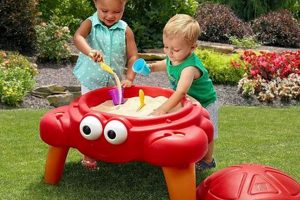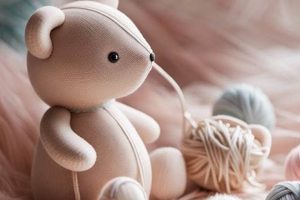Playthings designed to encourage infants to spend time on their stomachs are frequently utilized during developmental stages. These items range from simple, high-contrast images to more complex, multi-sensory devices. For example, a soft, plush mat featuring crinkling textures and attached mirrors can be categorized under this type of developmental aid.
Introducing such objects is considered beneficial for strengthening neck and shoulder muscles, promoting motor skill development, and preventing flat spots on the head. Historically, pediatricians have recommended integrating this activity into an infant’s daily routine from a young age, emphasizing its contribution to overall physical and cognitive advancement.
The following sections will detail various types of supportive aids available, explore safety considerations during utilization, and provide guidance on selecting appropriate options based on age and developmental milestones.
Guidance for Optimal Utilization of Infant Development Aids
Effective incorporation of objects that foster prone positioning can significantly contribute to an infant’s motor skill development. Adherence to the subsequent guidelines will maximize benefits and mitigate potential risks.
Tip 1: Initiate Early, Prioritize Short Bursts: Commence brief periods of prone positioning shortly after birth. Two to three sessions daily, lasting three to five minutes each, can gradually acclimate the infant to this posture.
Tip 2: Opt for Supportive Surfaces: Utilize a firm, flat surface, such as a blanket or specialized mat, to provide stability and reduce the risk of suffocation. Avoid excessively soft or uneven surfaces.
Tip 3: Supervise Constantly: Maintain unwavering vigilance during the entire period of prone positioning. Never leave an infant unattended in this position.
Tip 4: Engage and Motivate: Position appealing items within the infant’s reach to encourage head lifting and reaching. Rotate options regularly to sustain interest and promote diverse muscle engagement.
Tip 5: Monitor for Signs of Distress: Observe the infant for indications of discomfort, such as excessive crying, arching of the back, or changes in skin color. Immediately discontinue prone positioning if any of these signs are present.
Tip 6: Vary Sensory Input: Select items with diverse textures, colors, and sounds to stimulate sensory exploration and promote cognitive development during prone positioning sessions.
Tip 7: Consider Developmental Milestones: Adjust the complexity of items based on the infant’s current developmental stage. As the infant gains strength and coordination, introduce more challenging objects that encourage reaching and grasping.
The consistent and mindful application of these techniques enhances the effectiveness of developmental aids and optimizes the infant’s motor and sensory development.
The subsequent sections will address specific types of aids designed to promote prone positioning and provide recommendations for selecting appropriate options based on individual infant needs.
1. Sensory Stimulation
Sensory stimulation represents a cornerstone in early infant development, particularly during activities involving prone positioning. The deliberate integration of diverse sensory inputs into these aids facilitates neurological growth and fosters early learning experiences. This section explores specific facets of sensory stimulation crucial in the design and selection of these developmental resources.
- Visual Acuity Enhancement
High-contrast patterns, vibrant colors, and reflective surfaces are incorporated to stimulate visual development. Infants’ visual acuity is limited initially; therefore, the use of bold, simple designs captures their attention and promotes focus. An example is a black-and-white patterned board placed within the infant’s field of view, encouraging tracking and visual discrimination.
- Tactile Exploration and Motor Skills
Varied textures, such as plush fabrics, crinkling materials, and smooth surfaces, encourage tactile exploration. This stimulates nerve endings in the skin and promotes the development of fine motor skills as the infant reaches, grasps, and manipulates different textures. A developmental aid featuring a patchwork of fabrics with varying textures serves as an example.
- Auditory Development and Sound Localization
The inclusion of auditory elements, such as rattles, crinkling sounds, and gentle melodies, contributes to auditory development. These sounds encourage the infant to turn their head and localize the source, strengthening neck muscles and promoting spatial awareness. A soft toy with an embedded chime exemplifies this facet.
- Proprioceptive and Vestibular Stimulation
Some specialized aids incorporate gentle rocking or vibration to stimulate the proprioceptive and vestibular systems. This can enhance body awareness and promote balance development. An example is a gently vibrating pad designed for supervised prone positioning.
The strategic application of these sensory stimulation facets within items designed to encourage prone positioning enhances the developmental benefits for infants. Careful consideration of visual, tactile, auditory, and proprioceptive elements is essential when selecting aids to promote optimal sensory integration and motor skill development.
2. Motor Skill Development
Motor skill development is inextricably linked to the utilization of items designed to encourage prone positioning in infants. The act of engaging in this activity directly facilitates the development of essential gross and fine motor skills, influencing subsequent physical milestones.
- Neck Muscle Strengthening
Prone positioning necessitates that the infant lift and turn their head, directly strengthening the neck muscles. This strengthening is crucial for later head control, an essential precursor to sitting and crawling. For instance, an infant reaching for a visually stimulating item during prone positioning actively engages and strengthens these muscles.
- Shoulder and Back Muscle Development
Sustained prone positioning requires the engagement of shoulder and back muscles, fostering their development. This improved upper body strength contributes to the ability to push up, crawl, and eventually walk. Infants pushing up on their forearms to explore their surroundings during prone positioning exemplify this process.
- Core Strength and Stability
Maintaining balance and stability during prone positioning engages the core muscles, promoting their development. A strong core is fundamental for supporting posture, balance, and coordination throughout childhood. The act of an infant attempting to roll over from the prone position demonstrates core muscle activation.
- Hand-Eye Coordination
Reaching for and interacting with objects during prone positioning enhances hand-eye coordination. This coordination is essential for fine motor skills such as grasping, manipulating objects, and self-feeding. An infant reaching for a textured ring during prone positioning is actively developing this coordination.
The synergistic effect of these developmental processes highlights the significance of prone positioning as a foundational activity for motor skill acquisition. Items designed to facilitate this activity serve as valuable tools in supporting infants’ physical development, leading to enhanced motor control and coordination throughout their early years. The selection of appropriate items should align with the infant’s developmental stage to maximize benefits and promote safe exploration.
3. Safety Standards Compliance
Adherence to established safety standards is paramount in the design, manufacturing, and distribution of items intended for infant use. This is especially critical for those utilized during prone positioning activities, where the potential for injury or harm, though generally low with proper supervision, necessitates stringent safety measures.
- Material Toxicity and Chemical Exposure
Compliance mandates that materials used in the construction of items intended for prone positioning activities must be free from harmful chemicals, such as phthalates, lead, and BPA. Regulatory bodies, such as the Consumer Product Safety Commission (CPSC) in the United States, set limits for these substances. Failure to adhere to these limits can result in recalls and potential health risks for infants, including developmental issues and endocrine disruption.
- Small Parts and Choking Hazards
Safety standards dictate that items must be designed to prevent the detachment of small parts that could pose a choking hazard. Regulations, such as those outlined in ASTM F963, specify testing procedures to assess the security of components. Products failing these tests are deemed unsafe for infant use and present a significant risk of asphyxiation.
- Flammability Resistance
Items intended for infant use must meet flammability standards to minimize the risk of fire-related injuries. Regulations often require materials to self-extinguish within a specified timeframe when exposed to a flame. This is particularly relevant for soft toys and mats, where flammable materials could pose a serious hazard in the event of a fire.
- Structural Integrity and Durability
Compliance necessitates that items maintain structural integrity under normal use conditions. This includes resistance to tearing, breaking, or deformation that could create sharp edges or entrapment hazards. Testing protocols often involve subjecting items to stress tests to assess their durability and ensure they can withstand the rigors of infant use.
These facets of safety standards compliance underscore the importance of selecting items from reputable manufacturers who prioritize safety and adhere to regulatory requirements. Parents and caregivers should diligently verify that items intended for infant prone positioning activities meet established safety standards to mitigate potential risks and ensure a safe developmental environment.
4. Age Appropriateness
The selection of objects designed to support prone positioning activities is critically dependent on the infant’s developmental stage. Age appropriateness dictates the type, complexity, and features of items utilized to ensure both safety and efficacy in fostering motor and sensory development.
- Newborn Stage (0-3 Months): Minimal Stimulation and Support
During the initial months, an infant’s visual acuity and motor control are limited. Items with high-contrast patterns, such as black and white images, placed within close proximity, are suitable for visual stimulation. Soft, supportive surfaces, such as rolled towels or specially designed wedges, can assist in maintaining the prone position without overexertion. Avoid items with complex features or those requiring advanced motor skills.
- Early Development (3-6 Months): Introduction of Interactive Elements
As infants gain neck and upper body strength, objects that encourage reaching and grasping become appropriate. Items with varied textures, such as crinkling fabrics or soft rattles, can be introduced to stimulate tactile and auditory senses. Mirrors, positioned at a safe distance, can promote self-awareness and visual tracking. Ensure that any items introduced are free of small parts that could pose a choking hazard.
- Advanced Exploration (6-9 Months): Encouraging Mobility and Coordination
Infants at this stage exhibit greater mobility and coordination. Items that encourage reaching for objects at varying distances can help develop hand-eye coordination and gross motor skills. Toys with suction cups that adhere to the floor can provide a stable target for reaching. Textured mats with built-in obstacles can encourage crawling and exploration. Monitor the infant’s engagement and adjust the complexity of items accordingly.
- Pre-Crawling and Beyond (9+ Months): Supporting Transitional Movements
As infants prepare to crawl or transition into other forms of locomotion, items that support these movements become beneficial. Tunnels, soft blocks, and low-lying obstacles can encourage exploration and experimentation with different body positions. Ensure that the environment is free from hazards and allows for safe movement. Consider items that promote problem-solving skills, such as stacking cups or simple shape sorters, to stimulate cognitive development alongside motor skills.
The progression of items used during prone positioning should align with the infant’s evolving capabilities and developmental milestones. A systematic approach to selecting age-appropriate objects ensures that the activity remains both engaging and safe, maximizing the benefits for motor and sensory development.
5. Material Composition
The selection of materials in objects designed to support prone positioning in infants is a critical determinant of safety, durability, and developmental efficacy. Material characteristics directly influence the infant’s sensory experience and potential exposure to harmful substances.
- Phthalate-Free Plastics
Phthalates, commonly used as plasticizers, have been linked to endocrine disruption and developmental issues. Regulatory standards mandate limits on phthalate content in infant products. The use of phthalate-free plastics, such as polypropylene or polyethylene, mitigates this risk, providing a safer alternative for items that infants may mouth or come into prolonged contact with. Examples include smooth, molded plastic rattles and textured rings designed for grasping.
- Natural and Organic Fabrics
Fabrics in contact with the infant’s skin should prioritize natural and organic fibers, such as cotton, bamboo, or hemp. These materials minimize exposure to synthetic chemicals, dyes, and pesticides commonly found in conventional fabrics. Organic cotton, for instance, is cultivated without the use of synthetic pesticides and fertilizers, reducing the risk of skin irritation and allergic reactions. Soft, plush mats and fabric toys often utilize these materials.
- Non-Toxic Dyes and Finishes
Dyes and finishes applied to infant items must be non-toxic and free from heavy metals, such as lead and cadmium. These substances can be ingested through mouthing or absorbed through the skin, potentially leading to developmental delays and neurological damage. Water-based dyes and vegetable-based finishes are safer alternatives, minimizing the risk of chemical exposure. Brightly colored, patterned cloths and textured toys should utilize these safer alternatives.
- Durable and Washable Materials
The frequent cleaning and sanitation of infant items necessitate the use of durable and washable materials. Items constructed from materials that can withstand repeated washing cycles without degradation are essential for maintaining hygiene and preventing the accumulation of bacteria and allergens. Machine-washable fabrics and wipeable plastics contribute to ease of maintenance and long-term usability. Play mats and soft toys designed for prone positioning activities benefit from these characteristics.
The careful consideration of material composition in objects used to support prone positioning activities is crucial for safeguarding infant health and promoting optimal development. The selection of phthalate-free plastics, natural fabrics, non-toxic dyes, and durable materials contributes to a safer and more beneficial developmental experience.
Frequently Asked Questions About Infant Prone Positioning Aids
The following section addresses common inquiries regarding the selection and utilization of aids designed to promote prone positioning in infants. The information presented aims to provide clarity and guidance to caregivers seeking to optimize their infant’s developmental progress.
Question 1: At what age should prone positioning activities commence?
Prone positioning can be introduced shortly after birth, typically within the first few days or weeks, under close supervision. Initial sessions should be brief, lasting only a few minutes at a time, and gradually increased as the infant’s strength and tolerance improve.
Question 2: What constitutes a safe surface for prone positioning?
A firm, flat surface is essential to minimize the risk of suffocation or injury. A clean blanket, a designated play mat, or a firm mattress are suitable options. Avoid soft or uneven surfaces, such as pillows or excessively plush bedding.
Question 3: How frequently should prone positioning activities be performed?
Multiple short sessions throughout the day are generally recommended. Starting with two to three sessions, each lasting three to five minutes, and gradually increasing the duration and frequency as the infant grows stronger and more comfortable is advisable.
Question 4: What indicators suggest that an infant is experiencing distress during prone positioning?
Signs of distress may include excessive crying, arching of the back, changes in skin color (e.g., turning red or pale), or difficulty breathing. If any of these signs are observed, the activity should be discontinued immediately, and the infant should be returned to a supine position.
Question 5: How should items be selected to promote prone positioning?
Items should be age-appropriate, free from small parts that could pose a choking hazard, and constructed from non-toxic materials. High-contrast images, textured surfaces, and soft toys can stimulate visual, tactile, and auditory senses. As the infant develops, items that encourage reaching and grasping can be introduced.
Question 6: What is the role of supervision during prone positioning?
Constant and direct supervision is paramount during all prone positioning activities. Never leave an infant unattended in this position, as the risk of suffocation or injury is present. Caregivers should remain within arm’s reach and monitor the infant’s well-being at all times.
In summary, safe and effective prone positioning activities require careful consideration of the infant’s age, developmental stage, and individual needs. Vigilant supervision and the selection of appropriate items are essential components of this developmental practice.
The subsequent section will provide a concluding overview of the key benefits and considerations associated with the utilization of items designed to support infant prone positioning.
Conclusion
This exploration of aids designed to encourage prone positioning highlights the necessity of careful selection and responsible application. The developmental benefits, ranging from enhanced motor skills to sensory stimulation, are contingent upon adherence to safety standards, age-appropriateness, and informed understanding of material composition. Disregard for these factors can diminish the advantages and potentially introduce risks.
Therefore, informed decision-making regarding these items is paramount. Parents and caregivers bear the responsibility of prioritizing infant well-being by selecting products from reputable manufacturers, adhering to safety guidelines, and adapting practices to suit individual developmental needs. Only through such diligence can the potential benefits of these developmental aids be fully realized, contributing to a foundation for future growth and well-being.







